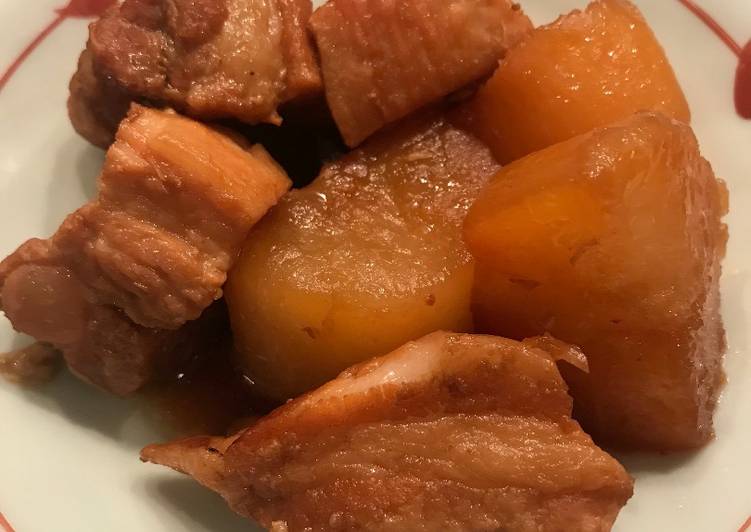Pork and Daikon (white radish) Nikomi (stew). Daikon, also known as white radish, Japanese radish, Chinese radish, winter radish, and luobo, is popular in Japanese, Chinese, and other Asian cuisines. The vegetable resembles a large white plump carrot and is commonly eaten raw, cooked, or pickled. A simple braised white radish (daikon) becomes a surprisingly tasty dish when cooked in a thick soy flavoured sauce with pork mince (ground pork).
 Gyusuji Nikomi (牛筋煮込み) is probably the most popular beef tendon dishes in Japan. Gyusuji (牛筋) means beef tendons and nikomi means stew in Japanese. Beef tendons are prepared first by boiling and simmering, and only after properly prepped, they are stewed in a soy sauce based savory dashi.
Gyusuji Nikomi (牛筋煮込み) is probably the most popular beef tendon dishes in Japan. Gyusuji (牛筋) means beef tendons and nikomi means stew in Japanese. Beef tendons are prepared first by boiling and simmering, and only after properly prepped, they are stewed in a soy sauce based savory dashi.
Hey everyone, hope you're having an amazing day today. Today, I'm gonna show you how to prepare a special dish, pork and daikon (white radish) nikomi (stew). One of my favorites. This time, I am going to make it a bit unique. This will be really delicious.
Pork and Daikon (white radish) Nikomi (stew) is one of the most popular of current trending foods in the world. It's easy, it's quick, it tastes delicious. It's appreciated by millions every day. Pork and Daikon (white radish) Nikomi (stew) is something which I've loved my whole life. They're fine and they look wonderful.
Daikon, also known as white radish, Japanese radish, Chinese radish, winter radish, and luobo, is popular in Japanese, Chinese, and other Asian cuisines. The vegetable resembles a large white plump carrot and is commonly eaten raw, cooked, or pickled. A simple braised white radish (daikon) becomes a surprisingly tasty dish when cooked in a thick soy flavoured sauce with pork mince (ground pork).
To begin with this recipe, we must prepare a few ingredients. You can cook pork and daikon (white radish) nikomi (stew) using 7 ingredients and 5 steps. Here is how you can achieve that.
The ingredients needed to make Pork and Daikon (white radish) Nikomi (stew):
- {Take 800 g of Pork Belly.
- {Prepare 1 of Large Daikon (white radish).
- {Prepare 5 Slices of ginger*.
- {Take 4 tbsp of Soy Sauce*.
- {Make ready 50 ml of Water*.
- {Take 2 tbsp of Sake(or white wine)*.
- {Get 4 tbsp of Sugar*.
Daikon is a long white Japanese radish, which has a crunchy texture and a light peppery and sweet taste. The Japanese variety is commonly known as Japanese daikon, and it is said there is more daikon produced in Japan than any other vegetable. The daikon radish salad is packed with flavors and tastes great as a side with other veg and non-veg main course dishes. · Pressure cooked in savory Japanese seasonings, this Japanese Beef Tendon Stew (Gyusuji Nikomi) is incredibly. Daikon Radish with White Miso Sauce (Furofuki Daikon).
Instructions to make Pork and Daikon (white radish) Nikomi (stew):
- Cut the pork belly in 3cm width. Peel the white radish, cut vertically in half, then in 3 cm width..
- Braise the pork in a pan in mid heat for 6 minutes till golden. Pour water to cover, bring to boil and simmer for 5 min. Discard the water..
- Place the pork, radish and all of the seasoning with * in the pressure cook. Cook in mid pressure for 20 minutes..
- Once done, remove the lid and cook in low-mid heat till the sauce is dense.
- .
Other root vegetables, such as turnips Daikon is a long white Japanese radish, which has a crunchy texture and a light peppery and sweet taste. Mizoreni: Pork Meatball and Daikon Soup Recipe We are making Motsu Nikomi, pork chitterlings stew, using a pressure cooker. There isn't any unwanted smells of motsu. The tender motsu has absorbed the broth.
So that's going to wrap it up for this exceptional food pork and daikon (white radish) nikomi (stew) recipe. Thanks so much for reading. I'm sure that you will make this at home. There is gonna be interesting food at home recipes coming up. Remember to save this page in your browser, and share it to your loved ones, friends and colleague. Thanks again for reading. Go on get cooking!


0 Comments